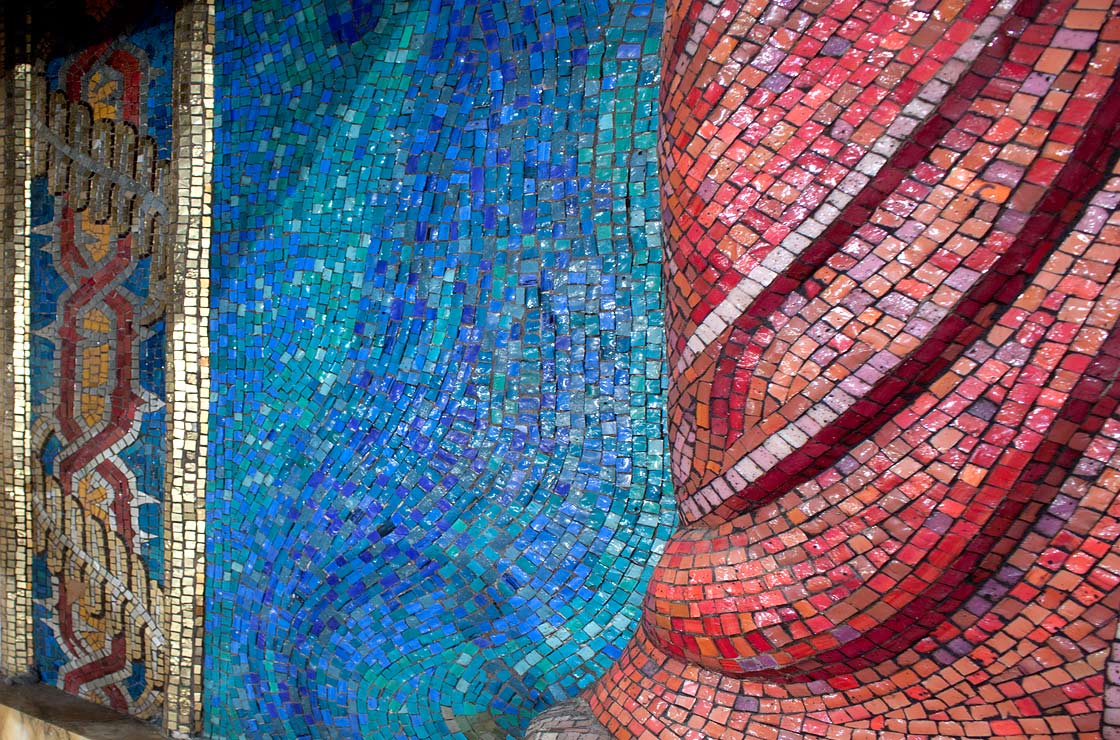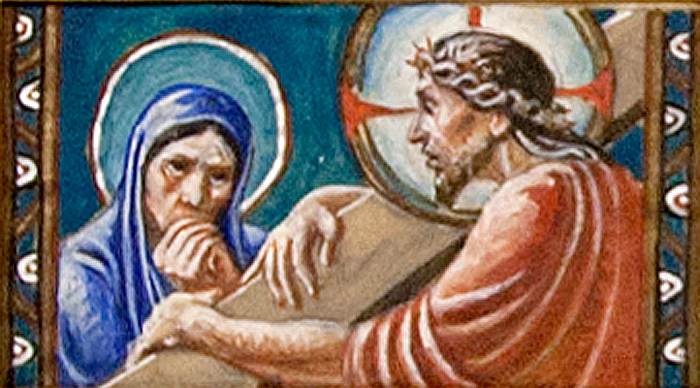Hildreth Meière Documentary Series - Watch Trailer
Hildreth Meière Documentary Series - Watch Trailer
Commissioned by: Henry D. Dagit & SonsArtistic Collaborator: Helene Sardeau, relief sculptureMedium: glass mosaicFabricated by: Pühl & WagnerInstalled by: Ravenna MosaicsNot visible

Interior of St. Katharine of Sienna. Archdiocese of Baltimore, Associated Archives at St. Mary's Seminary & University, Baltimore, MD
When it was completed in 1933, St. Katharine of Sienna was considered an ecclesiastical jewel that garnered Philadelphia architect Henry D. Dagit, a specialist in Catholic churches, an honorary award from the Philadelphia chapter of the Architectural Institute of America. Hildreth Meière designed a Crucifixion for the main altar, an Annunciation for the left side altar, and St. Joseph and the Angel for the right side altar.

Annunciation

Crucifixion

St. Joseph and the Angel
Meière collaborated on the altarpieces with sculptor Helene Sardeau, who gave high-relief form to Meière’s figures that were fabricated in glass mosaic by Puhl & Wagner in Berlin, Germany, and installed by the Ravenna Mosaic Company.

Detail showing mosaic-covered high relief

Detail of mosaic folds in high relief
Meière’s one-time collaboration with Sardeau demonstrates a meeting of minds and similar aesthetic approach to the commission. One writer’s description of Sardeau could just as well be applied to Meière: “Her canons of art are thoroughly classical, prohibiting in her work all mere decoration, flamboyance, and emotional effusiveness. . . .”1 Although Meière’s figure of Christ looks Romanesque, her other figures are elongated, especially the angels, and have a more contemporary look.
In addition to the high-relief altarpieces, Meière designed flat glass mosaic panels for the walls of the nave depicting Stations of the Cross. Puhl & Wagner fabricated the panels in Berlin, and Ravenna Mosaics set them into the walls of the nave:

Jesus is Crucified, wall panel in nave. Archdiocese of Baltimore, Associated Archives at St. Mary's Seminary & University, Baltimore, MD

Jesus at the Tomb, wall panel on right, with St. Joseph altarpiece visible on left. Archdiocese of Baltimore, Associated Archives at St. Mary's Seminary & University, Baltimore, MD
Meière made a series of final sketches for Stations of the Cross:

Studies in gouache for Stations of the Cross. Saint Louis University Archives, DOC REC 50 (Ravenna Mosaic Company Records), St. Louis, MO

Sketch in gouache for Jesus Meets His Mother

Jesus Meets His Mother, inset wall panel
By 1969 St. Katharine of Sienna had been converted into a multi-purpose community center, with the sanctuary serving as a gymnasium. Remarkably, no damage was done to Meière’s altarpieces. In 1974, the church and rectory were sold to the East-Side Baptist Church.2
Today the Greater Gethsemane Missionary Baptist Church, with a congregation of over 2,000 people, maintains the church with great care. Because the congregation is Baptist and does not want to view a Crucifixion scene, Meière’s high relief mosaics on the main and side altars have been covered with blue drapery and are not readily visible. The two remaining mosaic panels from Meière’s Stations of the Cross set into the walls of the nave—Jesus is Crucified and Jesus Meets his Mother—have also been covered.
Frank Crowninshield, “Helene Sardeau,” (New York: Ehrich Galleries, 1929), George Biddle Papers, Box 26, Library of Congress, Washington, DC. In 1931 Sardeau had married George Biddle, whom Meière knew from the National Society of Mural Painters. Like Meière, Sardeau had studied at the Art Students League in New York. She had maintained a studio in Paris for several years and worked in Italy for a year just prior to collaborating on the commission for St. Katharine of Sienna.
For the history of the conversions of the church, see J. Uttenreither, Jr., “St. Katharine’s will celebrate 75th birthday,” The Catholic Review, November 11, 1977.

Greater Gethsemane Missionary Baptist Church
2525 E Preston St
Baltimore, MD 21213